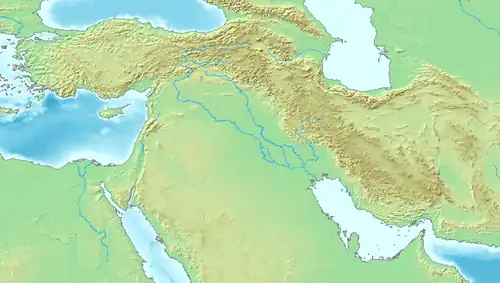| Ur-Pabilsag 𒌨𒀭𒉺𒉋𒊕 | |
|---|---|
| King of Ur | |
 Enthroned King of Ur, on the Standard of Ur, found in grave PG 779, possibly belonging to Ur-Palbisag. | |
| Reign | fl. circa 2600 BCE |
| Predecessor | A-Imdugud |
| Successor | Meskalamdug |
| House | First Dynasty of Ur |
Ur-Pabilsag (𒌨𒀭𒉺𒉋𒊕, ur-dpa-bil2-sag) was an early ruler of the First Dynasty of Ur in the 26th century BCE. He does not appear in the Sumerian King List, but is known from an inscription fragment found in Ur, bearing the title "Ur-Pabilsag, king of Ur".[1][2] It has been suggested that his tomb is at the Royal Cemetery at Ur (Grave PG 779).[3][4] He may have died around 2550 BCE.[5]
It also has been suggested that Ur-Pabilsag was the son of king A-Imdugud, known from grave PG 1236, which is the largest and probably the earliest tomb structure at the Royal Cemetery at Ur.[6] The tomb of Ur-Pabilsag (Grave PG 779) is generally considered as the second oldest at the site, and probably contemporary with grave PG 777, thought to be the tomb of his queen.[6] Meskalamdug (grave PG 755, or possibly PG 789) was his son.[7]
Artifacts
Several artifacts are known from tomb PG 779 at the Royal Cemetery at Ur, such as the famous Standard of Ur, and decorated shell plaques.[8][9]
_(14767391765).jpg.webp) Tomb of Ur-Pabilsag in the center (PG 779, marked "A"), with the tomb of Meskalamdug on the left (PG 755, marked "B"), next to the royal tomb of the queen of Ur-Pabilsag (PG 777, marked "C").
Tomb of Ur-Pabilsag in the center (PG 779, marked "A"), with the tomb of Meskalamdug on the left (PG 755, marked "B"), next to the royal tomb of the queen of Ur-Pabilsag (PG 777, marked "C"). Plan of grave PG 779. The Standard of Ur was located in "S"
Plan of grave PG 779. The Standard of Ur was located in "S"_(14744430356).jpg.webp) Grave PG 779, the tomb of Ur-Pabilsag.
Grave PG 779, the tomb of Ur-Pabilsag._(2).jpg.webp) The Standard of Ur, from tomb PG 779.
The Standard of Ur, from tomb PG 779._(14580929038).jpg.webp) Shell inlay from tomb PG 779
Shell inlay from tomb PG 779 King at war, with soldiers, from the Standard of Ur.
King at war, with soldiers, from the Standard of Ur.
See also
References
- ↑ Inscription "1. {d}LAK566 2. ur-{d}pa-bil2-sag3. lugal uri2#[{ki}-ma]" on fragment BM 124348 in "CDLI-Found Texts". cdli.ucla.edu.
- ↑ For a photograph: Benati, Giacomo. The "Archaic I" Phase of the Ziqqurat Terrace at Ur: A Contextual Re-assessment. p. 216, Cat. 33.
- ↑ Art of the First Cities: The Third Millennium B.C. from the Mediterranean to the Indus. Metropolitan Museum of Art. 2003. p. 96. ISBN 978-1-58839-043-1.
- ↑ Reallexikon der Assyriologie und Vorderasiatischen Archäologie. De Gryuter. 2015. p. 437.
- ↑ Hamblin, William James. Warfare in the ancient Near East to 1600 BC: holy warriors at the dawn of history, p. 49. Taylor & Francis, 2006. ISBN 978-0-415-25588-2
- 1 2 Reade, Julian (2003). Art of the First Cities: The Third Millennium B.C. from the Mediterranean to the Indus. Metropolitan Museum of Art. pp. 94–96. ISBN 978-1-58839-043-1.
- ↑ Reade, Julian (2003). Art of the First Cities: The Third Millennium B.C. from the Mediterranean to the Indus. Metropolitan Museum of Art. p. 96. ISBN 978-1-58839-043-1.
- ↑ Hall, H. R. (Harry Reginald); Woolley, Leonard; Legrain, Leon (1934). Ur excavations. Trustees of the Two Museums by the aid of a grant from the Carnegie Corporation of New York. p. Plaques 116, 117.
- ↑ Hamblin, William James. Warfare in the ancient Near East to 1600 BC: holy warriors at the dawn of history, p. 49. Taylor & Francis, 2006. ISBN 978-0-415-25588-2
Sources
- Jane McIntosh: Ancient Mesopotamia. ABC-CLIO 2005, ISBN 1-57607-965-1, p. 73 (restricted online version (google books))
- Leonard Woolley: The Sumerians. p. 38 (restricted online version (google books))

